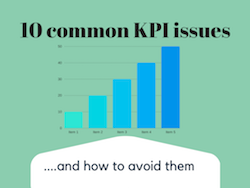 Key Performance Indicators are prevalent in most businesses. They are a great mechanism for measuring performance against those actions that relate back to individual business goals and objectives.
Key Performance Indicators are prevalent in most businesses. They are a great mechanism for measuring performance against those actions that relate back to individual business goals and objectives.
However, poorly chosen or badly implemented KPI’s can reduce the link back to business objectives and make it harder to communicate the business direction and performance to the wider business and stakeholders.
Some businesses fail to see the link and are overzealous on KPI selection, choosing:
a) too many and
b) the wrong indicators,
this pushes precious resources into chasing the wrong actions.
Most business objectives will require a selection of different KPIs. Selection can be a difficult juggling act and the business needs to align it’s KPI’s to what actually matters encouraging performance improvement whilst not encouraging the wrong behaviors that might be detrimental i.e. ensuring the numbers, not the performance meets the requirements.
In developing their KPIs most businesses will face a variety of common challenges. In this article, we’ll look at 10 of the more common failings that businesses make when developing their KPI’s.
This failure can have a significant impact on their ability to deliver their business strategy. I hope that this gives you some insight on how you can develop your indicators to better suit your business.
Do remember that production of KPI’s is not a one-off process but one that can be refined continually. There are no guarantees, what works excellently for one business may not for another. Contributory factors like data, review cadence can have a significant bearing. Given this, when developing your KPI set ensure that you brainstorm your ideas with your team, understand what actions may be taken from poor performance, consider what aspect of your business you’re looking to interpret and once launched continue to refine.
So here without further ado is our list of ten common mistakes businesses make when launching KPI’s.
1. Choosing metrics that always deliver excellent results.
Selecting measures just because they will score consistently well is meaningless. They impose over achievement and fill people with unnecessary confidence. This is especially true where a slight change or skew on the KPI may present a different (perhaps more realistic view) which is ignored in favor of a more positive outcome.
2. Failing to measure the big picture
Focussing on an element of the trend rather than the trend itself can lead, on occasion to incorrect actions being taken.
3. Failing to Align KPI’s with reporting periods.
Many indicators (particularly financial) need to be worked around reporting periods or when transactions get executed, failing to do so will fail to capture the trend and get inconclusive results. Ensure that when data is captured it’s representative of the process.
4. Data gathering introduces errors
In some cases, KPI’s may consume complex, disparate data sets. Where this requires a level of interpretation ahead of the KPI being formed the risk of introducing errors is greatly enhanced. Aim to keep KPI’s and the data they are generated from as simple as possible.
5. Over-reliance on lagging indicators
Some KPI’s may present historical datasets. Where there is an over-reliance on this type of metric the business may fail to understand and act on what is happening now. Any corrective action may be as a result of past information that is no longer valid.
6. Inappropriate KPI’s review cadence
KPI’s require appropriate cadence to review and agree on improvement actions. Failing to do this in a timely fashion will result in the power of the KPI being weakened.
7. KPI reviews focus on fault finding
The KPI exists to review performance – spending too much time finding fault either in the KPI’ itself or the way its presented can be determinantal. Also look to utilize the review process to commend teams where the KPI performance warrants it.
8. Assessing all KPI’s in the same manner
Not all KPI’s are built the same. Some have greater importance than others and some KPI’s require reading in a certain way. Assess each metric appropriately.
9. Failing to build KPI’s into performance management/continuous improvement system
KPI’s are there to present performance and drive appropriate actions. Failing to capitalize on the latter aspect renders them meaningless. All KPI’s must should have an owner who is responsible for the production of the KPI and the actions associated with them.
10. KPI’s are overly complex and difficult to interpret
KPI’s should be able to quickly and concisely present the performance of a particular aspect of the business. They shouldn’t be too esoteric that they require translating or interpreting. Simplistic KPI’s will always be more powerful over their more complicated counterparts.
Have some thoughts on KPI’s? We’d love your feedback into our comments section below.